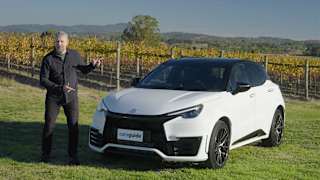Lexus IS250 2007 Review
By Paul Pottinger · 26 Feb 2007
Indeed, the sheer weight of its standard kit list is part of the reason the various IS250 models weigh appreciably more than the similarly priced — but under-equipped and underpowered — four-pot 3 Series, C-Class and Audi A4.Of course, we knew that 15 months ago, when the new-generation baby Lexus arrived to thrust a thorn into the side of this smug and complacent bund.Revisiting it is also to be reminded — refreshed, even — by the IS250's amiable daily disposition and its ability to step up in recreational driving.No matter the price ($54,390 for the manual Prestige model up to $79,000 for the Sports Luxury), every IS250 has the same 2.5-litre, quad-cam, multi-valve, direct-injection V6.With 153kW and 252Nm, it's an adequate unit that gets the fully fruited Sports Luxury we drove to 100km/h in a respectable, if not rapid, 8.8 seconds.Lighter, lesser versions shave almost half a sec off that.The choice between six-speed manual or Aisin auto is no choice at all, given that the working quality of the former rhymes with "shift", exacerbated by an awkwardly placed gearstick.So if it's an automatic choice, it is so by default, because, left in Drive, movement off the mark is sluggish. The tall-geared box will hunt before kicking down with a lack of grace that really isn't in keeping with a luxo six-speeder.And so the manual mode comes into its own. You can't override Drive with the steering wheel-mounted paddles — a la the systems used by Audi — but when the gearstick is shifted into sport mode, the Lexus respects your gear selections, holding to meltdown.With most of the IS250's bulk placed between its axles, you have balance and rear-wheel-drive dynamics to rival BMW's 3 Series — aspects that are readily appreciable when pressing on.Its appetite for bends is keen, with steering that firms up nicely when it most needs to and a feeling of agility in keeping with something lither and smaller.Aurally, the usually subdued engine acquires some throatiness in the upper rev range, though you could live without the beeping of the traction control, one of rather too many censorious sounds the Lexus is apt to make if you displease it.If the quick part of the IS250 equation isn't what is attracting buyers, it isn't hard to see where its charms lay.It drew more admiring comments and enquiries than anything we've had this side of exotic or mad money.Save for some slight awkwardness around the C-pillar — where it's more Hoffmeister Klutz than Kink — this least Lexus is the marque's sharpest looker.True, it's tight within, but far from intolerably so. DINKS or those with smaller offspring won't be bothered by the rear accommodation, nor that it's more cockpit than cabin up front.Actually, it's the inside story that persuaded us that the less you spend, the more convincing a buy the IS250 is.There are no options at all on the Sport Luxury version, and those on the cheaper variants aren't indispensable.On NSW goat tracks, you don't want bigger wheels — 16s would be fine.As good as the the touch-screen multimedia/satnav system is, it's hardly vital, and I'd pay extra not to have the headroom-eating sunroof.So far as options go, though, it's tough not to love seats that can blow either cool or warm air where the sun don't shine ...






